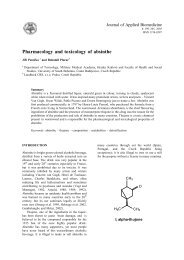Biomedically relevant chemical constituents of Valeriana officinalis
Biomedically relevant chemical constituents of Valeriana officinalis
Biomedically relevant chemical constituents of Valeriana officinalis
Create successful ePaper yourself
Turn your PDF publications into a flip-book with our unique Google optimized e-Paper software.
Patočka and Jakl: <strong>Biomedically</strong> <strong>relevant</strong> <strong>chemical</strong> <strong>constituents</strong> <strong>of</strong> <strong>Valeriana</strong> <strong>of</strong>ficinalis<br />
The mechanism <strong>of</strong> action <strong>of</strong> valerian in general,<br />
and in particular as a mild sedative, remains<br />
unknown. The aim <strong>of</strong> this article is to describe the<br />
biomedically active <strong>chemical</strong> <strong>constituents</strong> <strong>of</strong> valerian,<br />
and to review, its chemistry, biochemistry,<br />
pharmacology and toxicology.<br />
BOTANY<br />
The family <strong>Valeriana</strong>ceae comprises 10 genera and<br />
about 300 species (Simpson 2006), or the <strong>Valeriana</strong><br />
genus is <strong>of</strong> the family Caprifoliaceae and comprises<br />
about 200 species (Judd et al. 2002). The<br />
<strong>Valeriana</strong>ceae are mostly distributed worldwide and<br />
consist <strong>of</strong> herbs, rarely shrubs, with opposite leaves,<br />
a sympetalous, spurred corolla, 1–4 stamens, and a<br />
tricarpellate, inferior ovary with 1 functional locule<br />
and a single, apical ovule, the fruit is an achene, with<br />
a pappuslike calyx in some members. The economic<br />
uses include some cultivated ornamentals (e.g.<br />
Centranthus) and minor edible, medicinal, or essential<br />
oil plants.<br />
ETHNOBOTANY<br />
<strong>Valeriana</strong> <strong>of</strong>ficinalis is native to Europe and Asia and<br />
has naturalized in eastern North America. This tall<br />
perennial prefers moist woodlands; it has been<br />
extensively cultivated in northern Europe. Most <strong>of</strong> the<br />
European supply is grown in Holland. It is cultivated<br />
in low lying, damp sandy humus with a lime fertilizer.<br />
It is harvested in the late fall and dried. V. <strong>of</strong>ficinalis<br />
is the species used in Europe. The genus contains<br />
over 250 species, with many more subspecies.<br />
V. fauriei is used in traditional Chinese and Japanese<br />
medicine (Huang 1999, Hikino et al. 1971, 1972a, b).<br />
V. capensis is used in African traditional medicine<br />
(Iwu 1993), V. edulis is used in Mexico and<br />
V. wallichii is used in India (Schulz et al. 1997).<br />
MEDICINAL USE<br />
The roots <strong>of</strong> V. <strong>of</strong>ficinalis known as valerian have a<br />
long history <strong>of</strong> use as a sedative medicine in Europe.<br />
Valerian is a mild sedative and sleep-promoting agent<br />
that is <strong>of</strong>ten used as a milder alternative or a possible<br />
substitute for stronger synthetic sedatives, such as the<br />
benzodiazepines, in the treatment <strong>of</strong> nervous states<br />
and anxiety-induced sleep disturbances (Miyasaka et<br />
12<br />
al. 2006). Presently, valerian extracts are available as<br />
dietary supplements, which are primarily comprised <strong>of</strong><br />
dried root or extracts from the root, formulated into<br />
tablets or s<strong>of</strong>t gelatin capsules. Each dose contains<br />
between approximately 50 mg and approximately<br />
1 gram <strong>of</strong> dried root or extract. The use <strong>of</strong> these<br />
dietary supplements is extensive, with an estimated<br />
210 million doses sold annually in the United States<br />
and 125 million doses sold annually in Europe<br />
(Grunwald 1995).<br />
It has been recommended for epilepsy but that is<br />
not supported by research (Spinella 2001). The current<br />
indications for valerian are restlessness, insomnia,<br />
nervousness, and tension (Tariq and Pulisetty 2008).<br />
Large doses are known to cause withdrawal symptoms<br />
when stopped (Garges et al. 1998), as it, as well as<br />
most all sleep aids, may result in dependency. Those<br />
with liver disease are advised not to use valerian<br />
(Cohen and Del Torro 2008). While shown to be an<br />
effective remedy for the reduction <strong>of</strong> anxiety, it has<br />
also been reported to cause headaches and night terrors<br />
in some individuals. This is due to the fact that some<br />
people lack a digestive conversion property necessary<br />
to effectively break down valerian. In these<br />
individuals, valerian can cause agitation (Dennehy et<br />
al. 2005).<br />
One study found that valerian tends to sedate the<br />
agitated person and stimulate the fatigued person,<br />
bringing about a balancing effect on the system<br />
(Müller and Klement 2006).<br />
It is not fully understood which <strong>constituents</strong> <strong>of</strong><br />
V. <strong>of</strong>ficinalis, and/or <strong>of</strong> the other heret<strong>of</strong>ore<br />
unidentified members <strong>of</strong> the <strong>Valeriana</strong>ceae family, are<br />
responsible for the sedative and/or anxiolytic action <strong>of</strong><br />
valerian extracts. Nevertheless, the valepotriates<br />
(iridoids) as well as valerenic acid, a sesquiterpenoid<br />
compound, and the derivatives <strong>of</strong> valerenic acid are<br />
present in valerian extracts. Of these components, the<br />
valepotriates and valerenic acids are generally<br />
considered to contribute to the sedative action <strong>of</strong><br />
valerian extracts, but have not been clearly and<br />
positively identified as such (Hendriks et al. 1981).<br />
CONSTITUENTS – CHEMISTRY AND<br />
PHARMACOLOGY<br />
Valerian contains over 150 <strong>chemical</strong> <strong>constituents</strong> and<br />
many <strong>of</strong> them are physiologically active (Jiang et al.<br />
2007). There is substantial variation in the <strong>chemical</strong><br />
<strong>constituents</strong> in plants from different sources and<br />
growing conditions, processing methods and storage<br />
conditions but the differences are small (Wagner et al.<br />
1972). In order to guarantee the quality <strong>of</strong> the drug,





